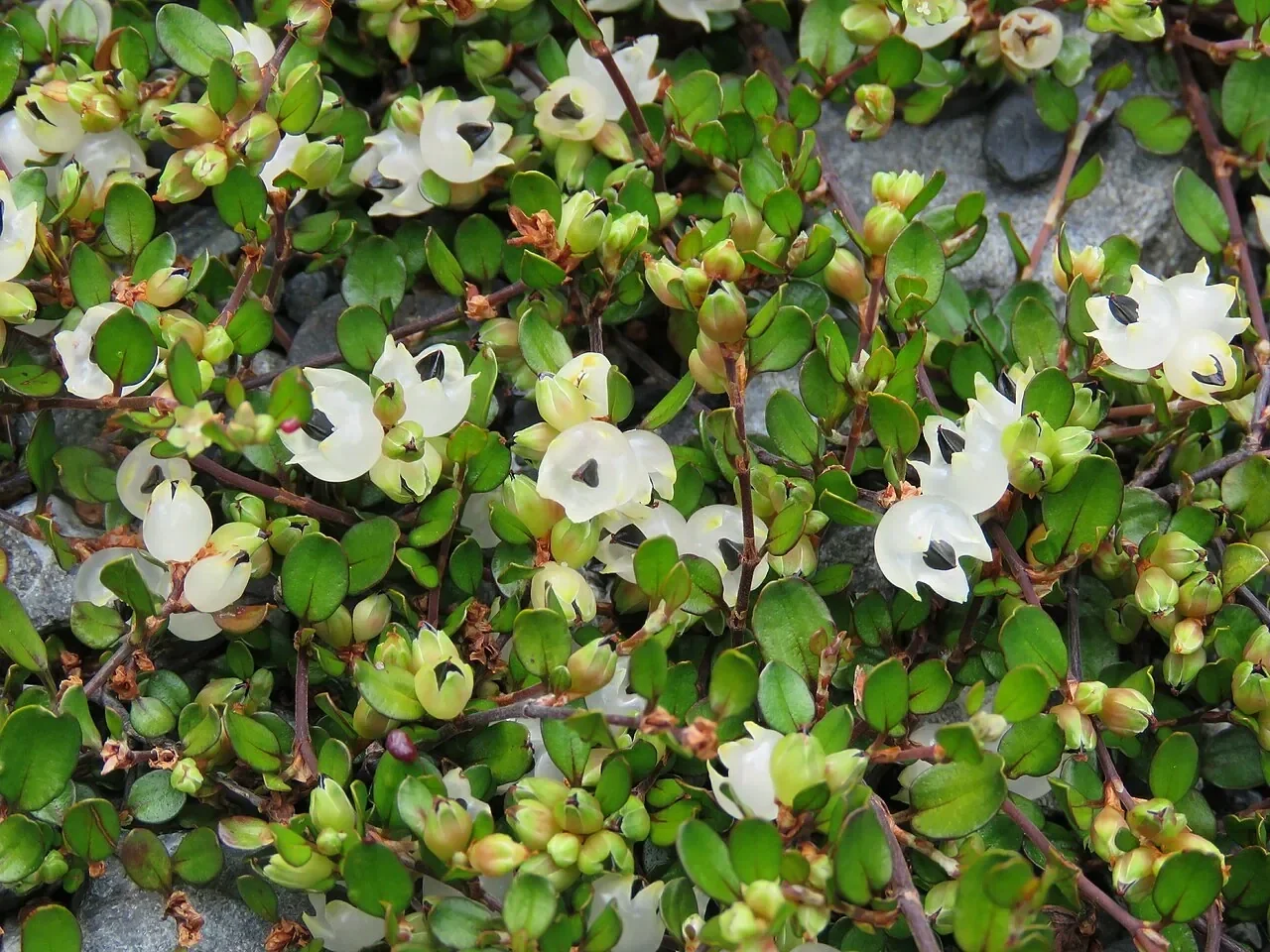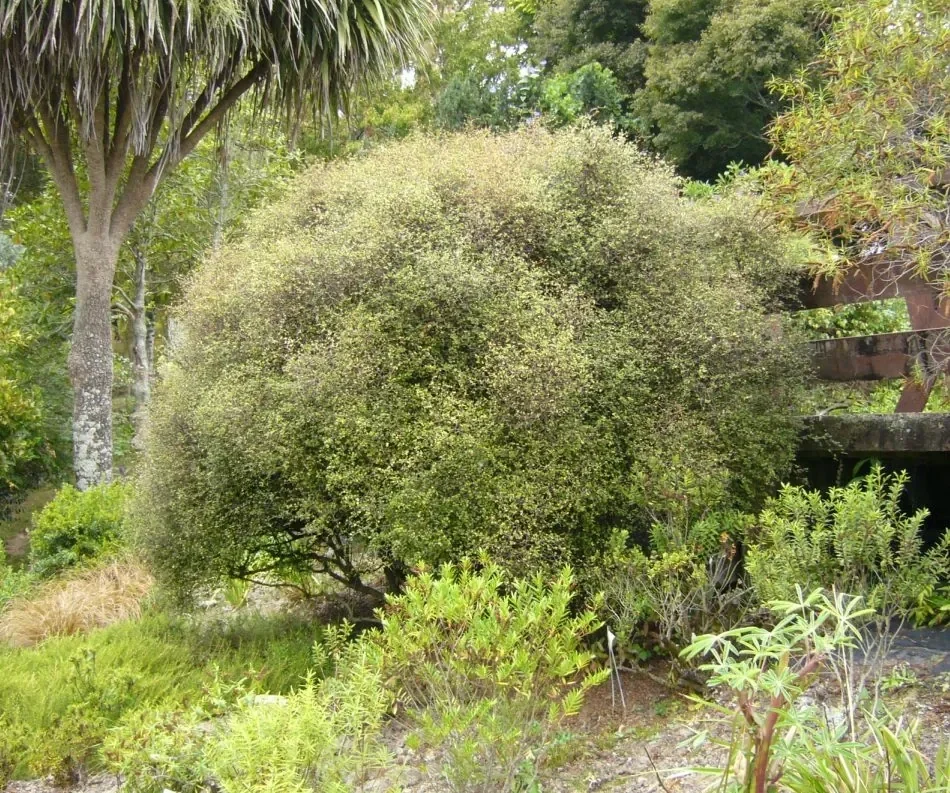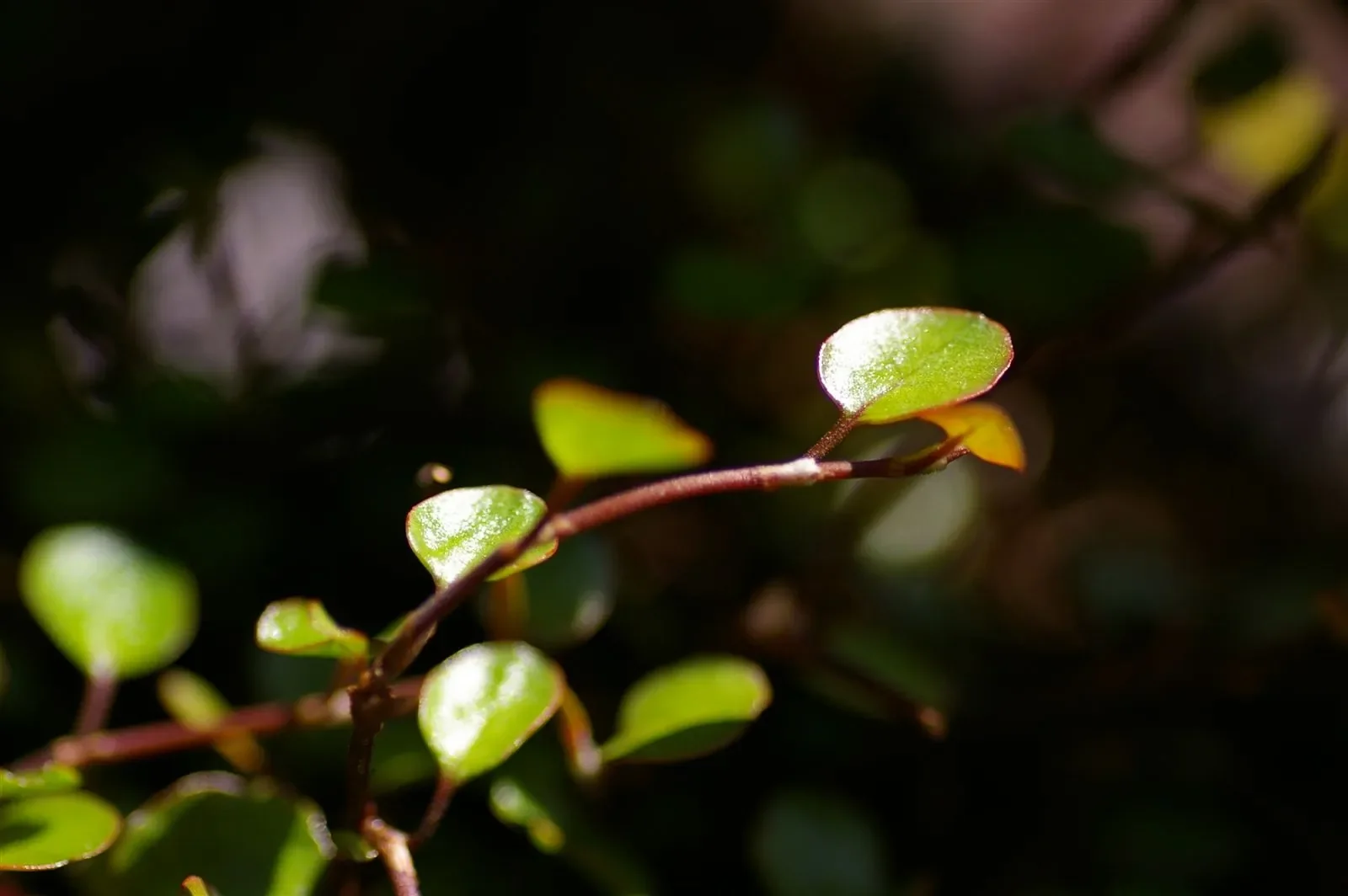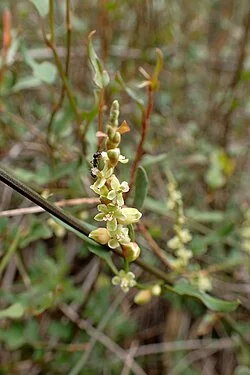
Creeping Pōhuehue
Muehlenbeckia axillaris
Introduction
Introduction Overview
Creeping p huehue ( Muehlenbeckia axillaris ) is a mat-forming native New Zealand groundcover with wiry stems and small, round leaves. It is valued for its ability to cover rocky ground and suppress weeds. ground covers .

Plant Description
Botanical Features
Creeping Pōhuehue ( Muehlenbeckia axillaris ), also known as creeping wire vine or sprawling wirevine, is a low-growing, deciduous or evergreen shrub that forms dense, wiry mats up to 1 meter in diameter. It is native to New Zealand and parts of Australia. It has thin, red-brown or bronzy copper-coloured, wiry stems with small, glossy, squarish to roundish leaves that are typically less than 1 cm in diameter and 2-4 mm thick. The leaves can be dark green and may turn rusty brown in the fall. The flowers are inconspicuous, yellowish-white, 4-8 mm in diameter, and appear in groups of up to three in the leaf axils, typically in July. The fruit is a small, black, shiny berry, up to 3.5 mm long, produced in late summer to fall.
Quick Facts
Key Facts
| Scientific Name | Muehlenbeckia Axillaris |
|---|---|
| Height | 2-10 cm (0.8-4 in); mat-forming groundcover |
| Spread | Up to 2 meters (6.5 ft) or more; spreads widely via wiry stems |
| Water Needs | Low to moderate; drought-tolerant once established |
| Light | Full sun to partial shade |
| Frost Tolerance | High; tolerates frost and cold |
| Salt Tolerance | Moderate; tolerates some coastal exposure |
| Growth Rate | Fast; quickly covers open ground |
| Lifespan | Perennial; long-lived in suitable conditions |
Climate Suitability
Regional Adaptation
| City | Suitability |
|---|---|
| Whangārei | Ideal |
| Auckland | Ideal |
| Hamilton | Ideal |
| Tauranga | Ideal |
| Rotorua | Ideal |
| Gisborne | Ideal |
| New Plymouth | Ideal |
| Napier | Ideal |
| Whanganui | Ideal |
| Palmerston North | Ideal |
| Wellington | Ideal |
| Nelson | Ideal |
| Christchurch | Ideal |
| Dunedin | Ideal |
| Invercargill | Ideal |
Muehlenbeckia is a hardy groundcover found throughout New Zealand, especially in open, rocky areas.
Regional Suitability
Natural Habitat
Natural Habitat Overview
Muehlenbeckia axillaris is naturally found in specific habitats throughout New Zealand. Understanding its natural environment helps in providing appropriate growing conditions in cultivation.
Plant Conservation
Muehlenbeckia axillaris , also known as creeping p huehue or creeping muehlenbeckia, is native to New Zealand and parts of Australia. The NZPCN lists its current conservation status as "Help."
Soil Requirements
Muehlenbeckia prefers well-draining soil with good organic content. It can adapt to various soil types but performs best in loamy or sandy soils.
Water Needs
Muehlenbeckia requires moderate watering, especially during establishment. Once established , it becomes more drought-tolerant.
Light Requirements
Muehlenbeckia grows best in full sun to partial shade, depending on the specific species and local climate conditions.
Temperature
Muehlenbeckia is well-adapted to New Zealand's temperate climate and can tolerate both warm summers and cool winters.
Planting Guide
When to Plant
The best time to plant Muehlenbeckia is during spring or autumn when soil temperatures are moderate and rainfall is reliable.
How to Plant
Dig a hole twice the width of the root ball and slightly deeper. Place Muehlenbeckia in the hole, backfill with soil, and water thoroughly. Mulch around the base to retain moisture.
Ecological Role
Contribution to Native Ecosystems
Muehlenbeckia axillaris plays an important ecological role by providing ground cover that helps prevent soil erosion and offers habitat for insects and small animals. Its dense growth supports biodiversity in native ecosystems.
Uses and Applications
Practical Applications
Muehlenbeckia has various practical and ornamental uses. From traditional Māori applications to modern landscaping, this versatile plant serves multiple purposes.
Historically, Muehlenbeckia was used by Māori for medicinal purposes, food, and cultural practices. These traditional uses reflect the deep knowledge of native plants.
Landscaping Uses
Design Ideas and Applications
Muehlenbeckia axillaris is ideal for landscaping due to its low-growing, mat-forming habit. It is commonly used in rock gardens, as ground cover, and for erosion control on slopes, providing texture and visual interest in garden designs.
Seasonal Care
Spring
Spring is the ideal time to plant Muehlenbeckia as the soil warms and new growth begins. Water regularly to establish roots and apply a light mulch to retain moisture.
Summer
During summer , Muehlenbeckia may require additional watering during dry spells. Monitor for pests and provide shade if needed in hot climates.
Autumn
Autumn is perfect for transplanting Muehlenbeckia as the cooler temperatures reduce stress. Reduce watering as growth slows.
Winter
Winter care for Muehlenbeckia involves minimal maintenance. Protect from severe frosts if necessary and avoid overwatering.
- Plant new specimens in well-drained soil
- Apply light mulch to retain moisture
- Water regularly to establish roots
- Monitor for drought stress
- Provide shade in hot climates
- Check for pest infestations
- Transplant established plants
- Reduce watering as growth slows
- Collect seeds for propagation
- Protect from severe frosts
- Avoid overwatering
- Minimal maintenance required
Pruning
Pruning Techniques
Creeping p huehue can be pruned in early spring or late fall. It is best to prune it lightly to encourage bushy growth and prevent it from becoming too sprawling.
How to Grow Creeping Pōhuehue
Creeping Pōhuehue is a mat-forming native New Zealand groundcover with wiry stems and small, round leaves. It is valued for its ability to cover rocky ground and suppress weeds, making it an excellent choice for rock gardens, alpine plantings, or as a lawn substitute in sunny to partially shaded areas. This resilient plant is highly adaptable to various soil types and conditions, including drought and moderate coastal exposure. Understanding its propagation methods is key to successfully growing this versatile species.
From Seed
Propagating Creeping Pōhuehue from seed is a viable method, though germination can be variable. Collect ripe seeds from the small, fleshy fruits when they are mature, typically in late summer or autumn. Clean the seeds thoroughly to remove any fleshy pulp. Sow the seeds in a well-draining seed-raising mix, lightly covering them. Maintain consistent moisture in the seed tray and keep it in a warm, bright location. Germination can take several weeks to months, so patience is key. Once seedlings have developed a few true leaves, they can be potted into individual containers and grown in a sheltered environment before planting out.
From Division
Division of established clumps is the easiest and most reliable method for propagating Creeping Pōhuehue. This is best done in spring or autumn. Carefully dig up a mature clump and gently separate it into smaller sections, ensuring each section has a healthy portion of roots and some foliage. Replant the divisions immediately into well-prepared soil that is well-draining. Water thoroughly after planting and keep consistently moist until new growth appears. This method is excellent for quickly expanding your stock of plants and for rejuvenating older, less vigorous clumps.
From Cuttings
Creeping Pōhuehue can also be propagated from softwood or semi-hardwood cuttings, typically taken in spring or summer from healthy, non-flowering stems. Cuttings should be about 5-10 cm long. Remove the lower leaves and dip the cut end in a rooting hormone. Insert the cuttings into a well-draining propagation mix (e.g., sand and perlite). Keep the cuttings in a warm, humid environment, out of direct sunlight, perhaps under a plastic dome or in a propagator. Rooting typically occurs within 4-6 weeks. Once rooted, the new plants can be potted on and grown in a sheltered environment until they are ready for planting.
Pests and Diseases
Common Issues
Creeping p huehue is generally resistant to pests and diseases. However, it can be susceptible to fungal infections if grown in poorly drained soil or if it becomes waterlogged.
Cultural Significance
Muehlenbeckia axillaris , also known as creeping wire vine or matted lignum, is primarily recognized for its horticultural and ecological attributes rather than extensive cultural significance in terms of symbolism or traditional beliefs.
Practical Uses and Ecological Value:
- Ground Cover and Erosion Control: It is widely used as a ground cover due to its dense, mat-forming growth habit, which helps suppress weeds and prevent soil erosion, particularly on sloping beds.
- Habitat and Food Source: The plant provides habitat for native copper butterflies, and its small, black-seeded white berries are a food source for birds and geckos. The fruit itself is small, sweet, and juicy, and can be eaten raw or cooked.
- Ornamental Use: It is valued in gardens for its unique growth habit, attractive foliage, and ability to thrive in various conditions, including rock gardens, containers, and as a trailing plant.
Bonus Tip
Expert Growing Advice
The small, shiny black fruits of Creeping Pōhuehue are edible, both raw and cooked. They are a favourite food of native lizards, which help to disperse the seeds.







